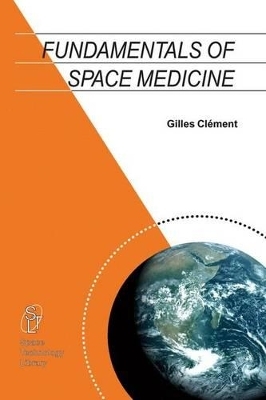
Fundamentals of Space Medicine
Kluwer Academic Publishers
978-1-4020-1598-4 (ISBN)
- Titel erscheint in neuer Auflage
- Artikel merken
Preface by Dr. Didier Schmitt. Preface by Dr. Douglas Hamilton. Foreword. Acknowledgements. I: Introduction to Space Life Sciences. 1: Space Life Sciences: What Is It? 1.1. Objectives. 1.2. The Space Environment. 1.3. Justification for Human Spaceflight. 1.4. Where we are. 2: The Legacy of Space Life Sciences Research. 2.1. Major Space Life Sciences Event. 2.2. Survising the Odyssey. 2.3. Life Support Systems. 3: Challenges Facing Humans in Space. 3.1. Astronauts' Health Maintenance. 3.2. Environmental Health during Space Missions. 3.3. Human Mars Mission. 3.4. Countermeasures. 3.5. Artificial Gravity. 3.6. A New Science is Born. 4: References. II: Space Biology. 1: What is Life? 1.1. Life on Earth. 1.2. Life on Mars. 2: Gravitational Biology. 2.1. Questions. 2.2. Results of Space Experiments. 2.3. Bioprocessing in Space. 3: Development Biology. 3.1. Questions. 3.2. Results of Space Experiments. 4: Plant Biology. 4.1. Questions. 4.2. Results of Space Experiments. 5: Radiation Biology. 5.1. Ionized Radiation in Space. 5.2. Biological Effects of Radiation. 6: ISS Facilities for Space Biology. 7: References. III: The Neuro-Sensory System in Space. 1: The Problem: Space Motion Sickness. 2: Vestibular Function. 2.1. The Vestibular System. 2.2. The Other Senses. 3: Effects of Spaceflight on Posture and Movement. 3.1. Rest Posture. 3.2. Vestibulo-Spinal Reflexes. 3.3. Locomotion. 3.4.Body Movement. 3.5. Eye Movement. 4: Effects of Spaceflight on Spatial Orientation. 4.1. Visual Orientation. 4.2. Cognition. 5: What Do We Know? 5.1. Space Motion Sickness (SMS) Experience. 5.2. Theories for Space Motion Sickness. 5.3. Countermeasures. 6: References. IV: The Cardio-Vascular System in Space. 1: The Problem: Postflight Orthostatic Intolerance. 2: Physiology of the Cardio-Vascular System. 2.1. Basics. 2.2. Control Mechanism. 3: Effects of Spaceflight on the Cardio-Vascular System. 3.1. Launch Position. 3.2. Early On-Orbit. 3.3. Later On-Orbit. 3.4. Postflight. 4: What Do We Know? 4.1. Orthostatic Intolerance. 4.2. Pulmonary Function. 4.3. Bed Rest. 5: Countermeasures. 5.1. In-flight. 5.2. End of Mission. V: The Musculo-Skeletal System in Space. 1: The Problem: Muscle Atrophy and Bone Loss. 1.1. Muscle Atrophy. 1.2. Bone Loss. 2: Muscle and Bone Physiology. 2.1. Muscle Physiology. 2.2. Bone Physiology. 3: Effects of Spaceflight on Muscle. 3.1. Decrease in Body Mass. 3.2. Decrease in Muscle Volume and Strength. 3.3. Changes in Muscle Structure. 4: Effects of Spaceflight on Bone. 4.1. Human Studies. 4.2. Animal Studies. 5: What Do We Know? 5.1. Muscle Atrophy. 5.2. Bone Demineralization. 6: Countermeasures. 6.1. Muscle. 6.2. Bone. 6.3. Aging and Space. 7: References. VI: Psycho-Sociological Issues of Spaceflight. 1: The Problem: Reaction to Stress. 1.1. Analogs. 1.2. Space Simulators. 1.3. Actual Space Missions. 1.4. Rules. 2: Individual Selection. 2.1. Select-Out Criteria. 2.2. Select-In Criteria. 2.3. Psychological Profile of Astronauts and Cosmonauts. 3: Crew Selection. 3.1. Sociological issues. 3.2. Selection issues. 4: Assessment of Behavior and Performance. 5: Psychological Training and Support. 5.1. Training. 5.2. Support. 6: References. VII: Operational Space Medicine. 1: What Is It? 1.1. Objectives. 1.2. Risk Assessment. 2: Astronaut Selection and Training. 2.1. Crew Position. 2.2. Physical Requirements for Astronaut Selection. 2.3. Astronaut Training. 3: Prevention: Health Hazards in Space. 3.1. Medical Events during Spaceflight. 3.2. Medical Aspects of Extra-Vehicular Activity. 3.3. Medical Problems of Radiation in Space. 3.4. Conclusion on Space Health Hazards. 4: Treatment: Space Medical Facilities. 4.1. Crew Health Care System (CHeCS). 4.2. Telemedicine. 4.3. Emergency and Rescue. 5: Future Challenges. 5.1. Human Needs for Long-Duration Missions. 5.2. Controlled Ecological Life Support System. 5.3. Terraforming. 5.4. Conclusion. 6: References. VIII: Space Life Sciences Investigator's Guide. 1: Resources and Constraints of Space Life Sciences Missions. 1.1. Opportunities for Space Life Sciences Experiments. 1.2. Constraints. 2: How to "Fly" an Experiment. 2.1. Flight Experiment Selection. 2.2. Experiment Design. 2.3. Hardware Selection. 2.4. Feasability. 2.5. Experiment Integration. 2.6. Crew Science Training. 2.7. In-Flight Science Operations. 2.8. Data Analysis. 3: References and Documentation. Index.
| Erscheint lt. Verlag | 1.1.2005 |
|---|---|
| Reihe/Serie | Space Technology Library ; 17 |
| Zusatzinfo | Illustrations, ports. |
| Sprache | englisch |
| Maße | 160 x 240 mm |
| Gewicht | 838 g |
| Themenwelt | Medizin / Pharmazie ► Medizinische Fachgebiete ► Arbeits- / Sozial- / Umweltmedizin |
| Naturwissenschaften ► Physik / Astronomie ► Astronomie / Astrophysik | |
| Technik ► Luft- / Raumfahrttechnik | |
| ISBN-10 | 1-4020-1598-4 / 1402015984 |
| ISBN-13 | 978-1-4020-1598-4 / 9781402015984 |
| Zustand | Neuware |
| Haben Sie eine Frage zum Produkt? |